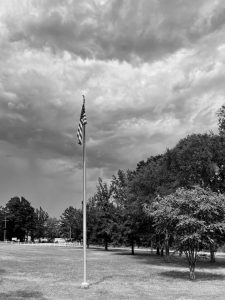The Time It Rarely Rained
It crept up out of Mexico, touching first along the brackish Pecos and spreading then in all directions, a cancerous blight burning a scar upon the land.
Just another dry spell, men said at first. Ranchers watched waterholes recede to brown puddles of mud that their livestock would not touch. They watched the rank weeds shrivel as the west wind relentlessly sought them out and smothered them with its hot breath. They watched the grass slowly lose its green, then curl and fire up like dying cornstalks.
Farmers watched their cotton make an early bloom in its stunted top, produce a few half-hearted bolls and then wither.
Men grumbled, but you learned to live with the dry spells if you stayed in West Texas; there were more dry spells than wet ones. No one expected another drouth like that of ’33.
And the really big dries like 1918 came once in a lifetime.
Why worry? They said. It would rain this fall. It always had.
But it didn’t. And many a boy would become a man before the land was green again.
— The Time It Never Rained, by Elmer Kelton
|———|
Kelton’s classic novel of the Texas drought of 1949 to 1957 comes to mind as we endure the worst drought the state has seen since 2011. Neither will compare, we pray, to what the state endured during those lean years. In 1952, the state’s monthly average rainfall fell to just three-hundredths of an inch — the lowest level since the weather bureau began collecting records in 1888. By comparison, the 16 or so inches we have received here at No-Name Farm thus far seems downright tropical.
Still, the land is drying up. Up the road, someone has cleared a spot to build a house. When the wind blows, as it does often these days, dust flies across the road in billowing clouds. The Bahia pasture in front of our house is brittle and crackles when walked upon. Fortunately, Bahia requires little moisture to survive and revive. I keep our small, fenced backyard alive with water from the well, which barely has enough pressure to power the tiny sprinkler attached to it. I have to go outside and move it every 10 minutes or so, to water another 3-foot square patch of grass. At least the water is free.
Rainfall chances show up in the weather app on my iPhone, only to disappear by the next day. Twice in the past few days, clouds have gathered, thunder rumbles in the distance, a few raindrops fall, and then the clouds dissipate. I look at the app for the next chance of rain. Maybe Monday, possibly Wednesday.
We’re fortunate to have only one four-legged animal that needs to graze, and there is enough on the ground for Pancho the Donkey. I know folks who are already scrambling for square bales for their horses, and others already pulling out round bales to feed cows, meaning there almost certainly will be a hay shortage come winter.
In 1952, three years into the drought, H.B. Fox was writing for Soil and Water Magazine. (I published a biography of Fox in 2018, titled Yours Faithfully, J.A.: The Life and Writings of H.B. Fox, the Circleville Philosopher. You can order your copy here.) Early on in his stint at the magazine, Fox wrote:
We were talking with a veteran stockman the other day, a man who has seen dry weather before and survived, and his advice was: never let a drouth run you out of the livestock business.
Now it may have rained by the time this gets into print, but at the writing Texas is still dangerously dry and 1952 could be a scant year if things continue that way.
Yet this stockman we’re talking about took an optimistic view. “Do you know,” he asked, “that every day that passes we’re one day closer to a rain?”
We appreciated this viewpoint, but after he left got to thinking: it’s true that every day that passes we’re one day closer to a rain, but it’s also true that we’re one day further away from the last rain. That’s the thing that hurts
As the drought entered its fifth year, in 1954, Fox and his boss went on a four-day tour of Northwest Texas. He came back and wrote a piece, titled “1500 Miles of Dust.” His opening lines:
I have just gotten back from a 1500-mile examination of a Texas dust storm, and I can report it’s sort of like throwing ashes out the back door against the wind. You wind up gritty from head to foot.
|———|
We have driven to Denton twice in the past month, helping daughter Abbie get settled in her new apartment and prepared to enter graduate school at University of North Texas. Not long after heading northwest, the land gets noticeably drier. Highway shoulders and medians are brown, whereas the land here retains a dim patina of green. Burn spots where grass fires ignited appear every few miles.
There’s a 45% chance of rain tomorrow, according to the weather app. Maybe we really are one day closer to a rain. God willing and praying the creeks do rise.
Leave a reply
Fields marked with * are required












